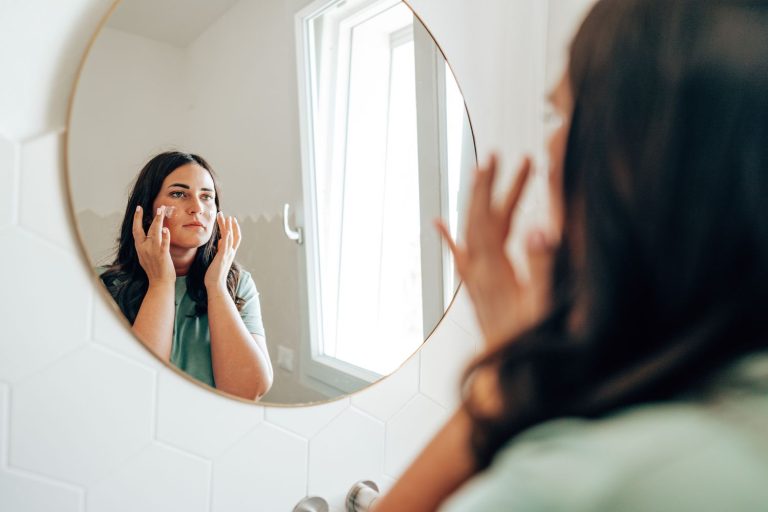Kojic acid is an organic acid naturally derived from specific types of fungi. It is used in various cosmetic products, including soaps, powders, serums, and creams, to help with hyperpigmentation and sun damage.
Jump to Key Takeaways.
1. May Treat Hyperpigmentation
The research on kojic acid is strongest regarding its skin-lightening effects. The Cosmetic Ingredient Review (CIR) approved using kojic acid for skin lightening in concentrations that do not exceed 1%.
Research shows that kojic acid may help treat hyperpigmentation by inhibiting excess melanin production. Kojic acid reduces melanin by interfering with the enzyme tyrosinase, which is needed to produce it. More research may be necessary for other uses of kojic acid.
2. May Treat Acne
Kojic acid has antifungal and antimicrobial properties that may help treat acne and acne scars. In lab studies, kojic acid destroyed common types of acne-causing bacteria, suggesting that it may help prevent acne caused by bacteria.
3. It Has Antioxidant Effects
Research suggests that kojic acid’s antioxidant properties help reduce free radicals and inhibit melanin production. This may make it effective for the treatment and prevention of hyperpigmentation and sun damage. It may also protect skin from UV rays, helping to prevent signs of aging.
4. May Help Collagen Levels
Kojic acid may indirectly help boost levels of collagen, a protein that influences skin health.
How Long Does Kojic Acid Take to Lighten Skin?
Kojic acid may help treat hyperpigmentation and work as a skin-lightening agent. The time it takes for kojic acid to lighten skin varies widely. However, research shows that it may take four to 12 weeks or more.
What You Need to Know Before Using Kojic Acid
Using kojic acid may result in side effects and other adverse events. If you’re using kojic acid, you may want to take the following precautions:
- Consult a professional: Kojic acid side effects may be more likely for those with sensitive skin. If you have sensitive skin, talk with a healthcare provider before using kojic acid.
- Check concentration: The CIR asserted that kojic acid is generally considered safe when used at 1% or less for skin lightening. However, some research indicates that kojic acid may still be safe at a concentration of 2%.
- Monitor reactions: Safety studies indicate that kojic acid may cause contact dermatitis in some people, especially those with sensitive skin. Contact dermatitis may cause red, itchy skin or a rash.
- Limit sun exposure: There is also evidence that long-term kojic acid use may make skin more sensitive to the sun, increasing the risk of sunburn.
- Do a patch test: Before using kojic acid for the first time, you should perform a patch test to ensure your skin doesn’t react badly.
- Avoid broken skin: Never apply kojic acid to broken or injured skin. Doing so may increase irritation.
Where Does Kojic Acid Come From?
Kojic acid is a by-product of the fermentation process of various types of fungi, including:
- Aspergillus flavus
- Aspergillus oryzae
- Aspergillus parasiticus
How Kojic Acid Works
Research suggests that kojic acid may work in a few different ways to improve the health of your skin:
- Binds to copper: Kojic acid lightens skin by binding to copper and reducing its activity, blocking tyrosinase, an enzyme needed for melanin production.
- Reduces inflammation: In lab studies, kojic acid suppressed inflammation, which may benefit skin health.
- Has antioxidant effects: Additional research shows that kojic acid is an antioxidant that can potentially help with skin aging and treat specific skin conditions. However, more research is needed to confirm these results.
How to Use Kojic Acid for Your Skin
You can use kojic acid in various ways to treat your skin, including the following.
- Formulations: Kojic acid can be used as a soap, serum, powder, or cream. It should also be applied topically.
- Powder application: You can add kojic acid powder to face masks, creams, lotions, and soaps.
- Availability: Kojic acid products are readily available online or in retail stores and beauty supply shops.
- Start slowly: You should initially use kojic acid in small amounts to let your skin adjust. Over time, you can increase the amount and frequency of your use.
- Sun sensitivity: Experts recommend applying kojic acid under a moisturizer and sunscreen. Kojic acid may increase your skin’s sensitivity to the sun, especially when first using it, so sunscreen application is vital.
- Professional guidance: For further advice on proper kojic acid use, consult a qualified healthcare provider, such as a dermatologist.
When to Consult a Dermatologist
A dermatologist is a medical doctor and skin expert who can help you learn more about kojic acid.
- Skin conditions: Experts recommend seeing a dermatologist before using kojic acid if you have any skin conditions or sensitive skin. A dermatologist can help determine if kojic acid is safe for you or if a different product is better.
- Safe usage: A dermatologist can also teach you how to use kojic acid properly. This may include how much kojic acid to use and how often.
- Side effects: Consult a dermatologist if you experience side effects while using kojic acid. A dermatologist may recommend stopping kojic acid if you experience side effects.
- Check concentration: Finally, although kojic acid is available over the counter, some products containing higher concentrations require a dermatologist’s prescription.
Key Takeaways
- Use cautiously: Kojic acid may help lighten skin and treat hyperpigmentation, but it may also cause sun sensitivity or irritation.
- Check concentration: Ensure products contain 1% or less kojic acid to stay within safe usage limits.
- Consult your healthcare provider: Speak with a dermatologist to determine if kojic acid is appropriate for your skin type and concerns.



:max_bytes(150000):strip_icc()/Lubeck-headshot-0579405875e54490895f690b1b864e04.jpeg)